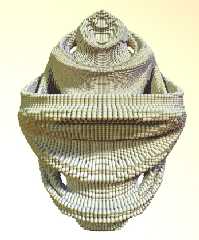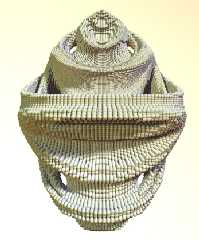 |
 |
|
 |
|
 |
|  |
|  |
|
 |
|
 |
|  |
|  |
|
 |
Created with a macro that scans the surface of any object and outputs points
on surface to an array...each point gets one ball in this picture. Took a
really long time to parse, 2 3/4 hours, 90k balls, area lights.
For those who can't see pictures embedded by the web interface, here's a
link, although this picture is much larger ~400kb
http://filebox.vt.edu/users/rbudge/pics/povray/hiressurfscan.jpg
Post a reply to this message
Attachments:
Download 'loressurfscan.jpg' (94 KB)
Preview of image 'loressurfscan.jpg'

|
 |
|  |
|  |
|
 |
|
 |
|  |
|  |
|
 |
Neat. But 2.75 hrs!! Sheesh.
> For those who can't see pictures embedded by the web interface,
Hey! I can see it with OE6. Thankyou Thorsten.
Alf
Post a reply to this message
|
 |
|  |
|  |
|
 |
|
 |
|  |
|  |
|
 |
<!DOCTYPE html PUBLIC "-//W3C//DTD HTML 4.01 Transitional//EN">
<html>
<head>
<meta content="text/html;charset=ISO-8859-1" http-equiv="Content-Type">
<title></title>
</head>
<body>
Budgery nous apporta ses lumieres ainsi en ce 2004/05/07 16:53... : <br>
<blockquote cite="midweb.409bf740dec57740a1fd027f0@news.povray.org"
type="cite">
<pre wrap="">Created with a macro that scans the surface of any object and outputs
points
on surface to an array...each point gets one ball in this picture. Took a
really long time to parse, 2 3/4 hours, 90k balls, area lights.
For those who can't see pictures embedded by the web interface, here's a
link, although this picture is much larger ~400kb
<a class="moz-txt-link-freetext"
href="http://filebox.vt.edu/users/rbudge/pics/povray/hiressurfscan.jpg">http://filebox.vt.edu/users/rbudge/pics/povray/hiressurfscan.jpg</a>
</pre>
<br>
<hr width="90%" size="4"><br>
<center><img src="cid:par### [at] qwerty gov"></center>
</blockquote>
Aparently, they managed to fix the web interface problem, I can see the
image <span class="moz-smiley-s1"><span> :-) </span></span><br>
<br>
Alain<br>
</body>
</html> gov"></center>
</blockquote>
Aparently, they managed to fix the web interface problem, I can see the
image <span class="moz-smiley-s1"><span> :-) </span></span><br>
<br>
Alain<br>
</body>
</html>
Post a reply to this message
Attachments:
Download '.jpg' (94 KB)
Preview of image '.jpg'

|
 |
|  |
|  |
|
 |
|
 |
|  |
|  |
|
 |
> But 2.75 hrs!! Sheesh.
I couldn't agree more.
I was watching the statistics right before the actual render started to go
and it was well over 20 billion tokens parsed.
The scanning algorithm had to work through 150^3 points using inside(...)
and for each point that was inside the object, it would compare with its 8
neighbors too determine whether it was on the surface.
Its all just some un-useless code that I'll use for a larger project later.
But it looks like this part works great, albeit freaky slow.
Post a reply to this message
|
 |
|  |
|  |
|
 |
|
 |
|  |
|  |
|
 |
On Fri, 07 May 2004 17:26:20 -0400, Alain <aze### [at] qwerty gov> wrote:
> Aparently, they managed to fix the web interface problem, I can see the
> image :-)
Well, almost...
With Opera's built-in newsreader, I get a link at the bottom of web-posted
posts. The link text is "imagename." (with 'imagename' being the actual
name of the image), and clicking on it opens the attached image in a new
window (as opposed to displaying the image inline as happens with other
posts). Note that the link text contains a dot, but no actual extension.
The same applies to the actual link address, which is something like
"attachment:/56/loressurfscan.", with the number and the image name
different for each post.
It's only 2 extra mouse clicks (one for displaying the image, and one for
closing it), so it's not really a big deal, but it does indicate that
there might still be something odd with the way posts are handled by the
web interface. The messages seem to be in "proper" multipart/mixed format;
it might be that the file extension gets lost somewhere.
---
FE gov> wrote:
> Aparently, they managed to fix the web interface problem, I can see the
> image :-)
Well, almost...
With Opera's built-in newsreader, I get a link at the bottom of web-posted
posts. The link text is "imagename." (with 'imagename' being the actual
name of the image), and clicking on it opens the attached image in a new
window (as opposed to displaying the image inline as happens with other
posts). Note that the link text contains a dot, but no actual extension.
The same applies to the actual link address, which is something like
"attachment:/56/loressurfscan.", with the number and the image name
different for each post.
It's only 2 extra mouse clicks (one for displaying the image, and one for
closing it), so it's not really a big deal, but it does indicate that
there might still be something odd with the way posts are handled by the
web interface. The messages seem to be in "proper" multipart/mixed format;
it might be that the file extension gets lost somewhere.
---
FE
Post a reply to this message
|
 |
|  |
|  |
|
 |
|
 |
|  |
|  |
|
 |
Alf Peake wrote:
> Hey! I can see it with OE6. Thankyou Thorsten.
Seconded!
Post a reply to this message
|
 |
|  |
|  |
|
 |
|
 |
|  |
|  |
|
 |
Hey, nice image... I like it!
Post a reply to this message
|
 |
|  |
|  |
|
 |
|
 |
|  |
|  |
|
 |
That's really sharp. I guess it wouldn't be possible to use trace()
becasue there's no good place to "shoot" from (?)
Anyway, 2-3 hours doesn't sound like a lot to me, for 90,000 spheres.
I've been doing some brute-force 3D mandelbrot sets on my old Mac G3,
and I'll start a run before bed, and parsing generally finishes some
time during breakfast.
I'd be interested in seeing the macro, once you're ready.
Thanks
Dave Matthews
Post a reply to this message
|
 |
|  |
|  |
|
 |
|
 |
|  |




![]()